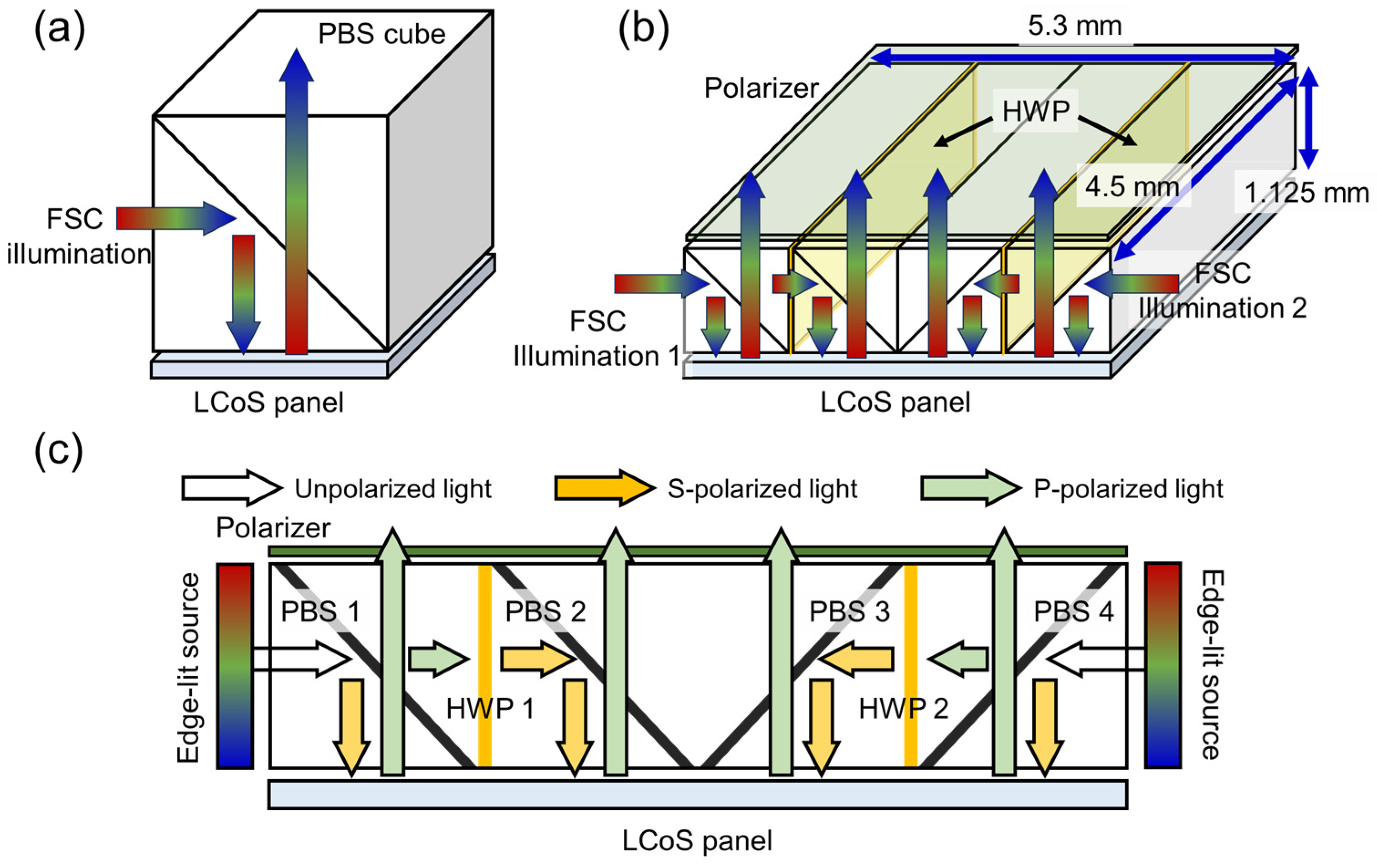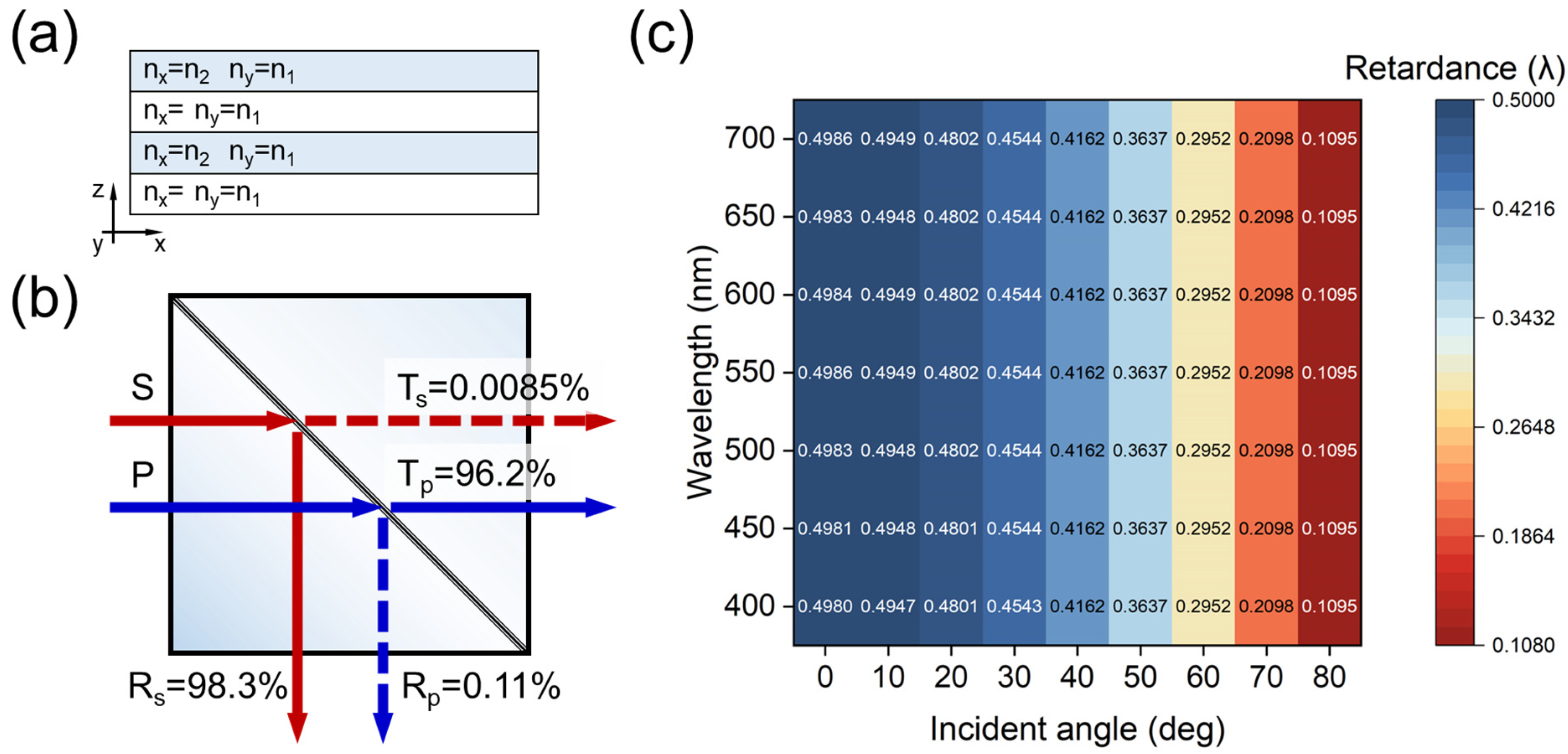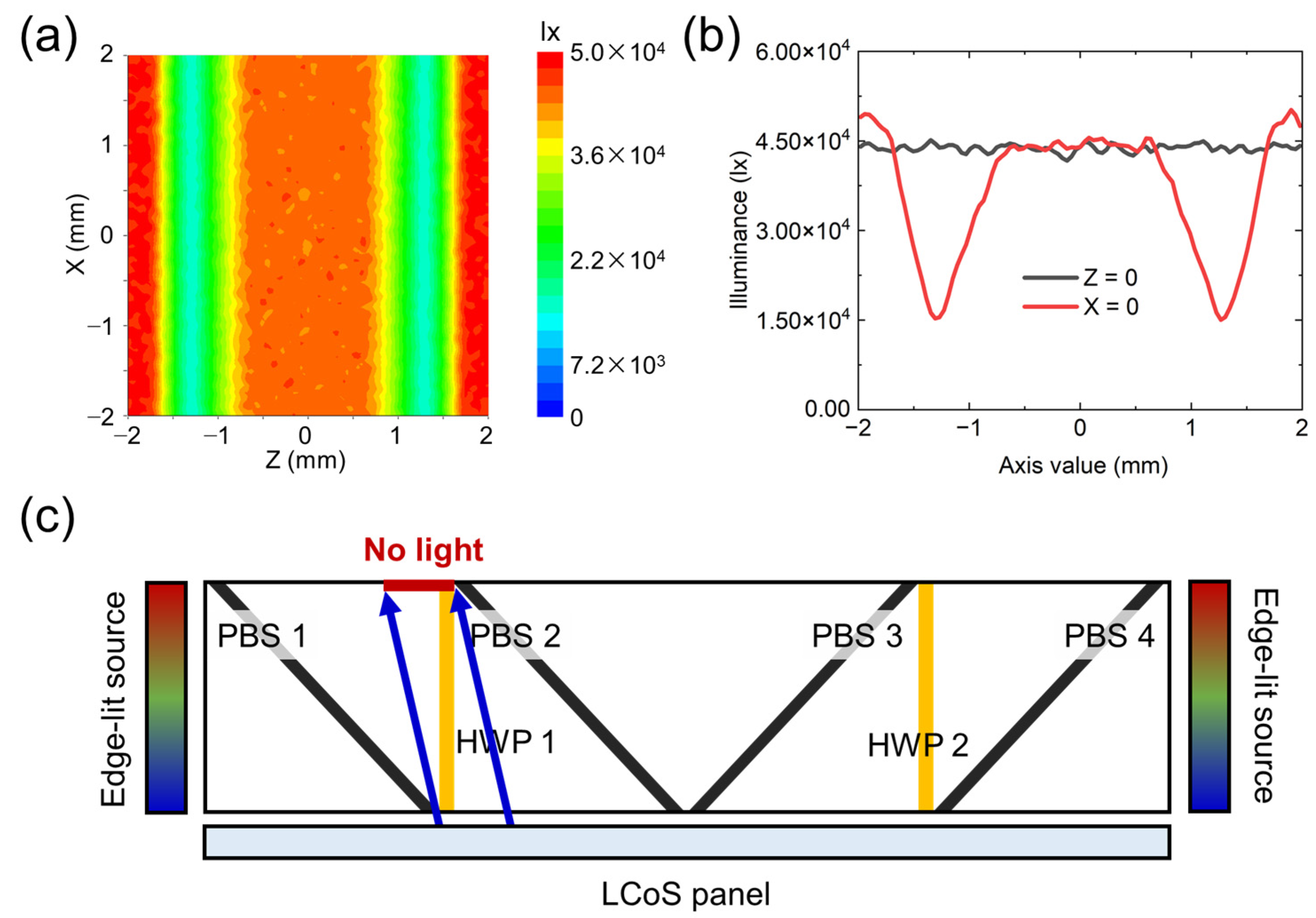Compact and High-Efficiency Liquid-Crystal-on-Silicon for Augmented Reality Displays
Abstract
1. Introduction
2. Methods
3. Simulations
4. Conclusions
Author Contributions
Funding
Institutional Review Board Statement
Informed Consent Statement
Data Availability Statement
Conflicts of Interest
References
- Azuma, R.T. A survey of augmented reality. Presence Teleoperators Virtual Environ. 1997, 6, 355–385. [Google Scholar] [CrossRef]
- Burdea, G.C.; Coiffet, P. Virtual Reality Technology; John Wiley & Sons: New York, NY, USA, 2003. [Google Scholar]
- Carmigniani, J.; Furht, B.; Anisetti, M.; Ceravolo, P.; Damiani, E.; Ivkovic, M. Augmented reality technologies, systems and applications. Multimed. Tools Appl. 2011, 51, 341–377. [Google Scholar] [CrossRef]
- Kress, B.C.; Cummings, W.J. Optical architecture of HoloLens mixed reality headset. In Proceedings of the Digital Optical Technologies 2017, Munich, Germany, 25–29 June 2017; Volume 10335, pp. 124–133. [Google Scholar]
- Chang, C.; Bang, K.; Wetzstein, G.; Lee, B.; Gao, L. Toward the next-generation VR/AR optics: A review of holographic near-eye displays from a human-centric perspective. Optica 2020, 7, 1563–1578. [Google Scholar] [CrossRef] [PubMed]
- Xiong, J.; Hsiang, E.L.; He, Z.; Zhan, T.; Wu, S.-T. Augmented reality and virtual reality displays: Emerging technologies and future perspectives. Light Sci. Appl. 2021, 10, 216. [Google Scholar] [CrossRef] [PubMed]
- Yin, K.; Hsiang, E.L.; Zou, J.; Li, Y.; Yang, Z.; Yang, Q.; Lai, P.-C.; Lin, C.-L.; Wu, S.-T. Advanced liquid crystal devices for augmented reality and virtual reality displays: Principles and applications. Light Sci. Appl. 2022, 11, 161. [Google Scholar] [CrossRef] [PubMed]
- Wu, H.-K.; Lee, S.W.-Y.; Chang, H.-Y.; Liang, J.-C. Current status, opportunities and challenges of augmented reality in education. Comput. Educ. 2013, 62, 41–49. [Google Scholar] [CrossRef]
- Webel, S.; Bockholt, U.; Engelke, T.; Gavish, N.; Olbrich, M.; Preusche, C. An augmented reality training platform for assembly and maintenance skills. Robot. Auton. Syst. 2013, 61, 398–403. [Google Scholar] [CrossRef]
- Poushneh, A.; Vasquez-Parraga, A.Z. Discernible impact of augmented reality on retail customer’s experience, satisfaction and willingness to buy. J. Retail. Consum. Serv. 2017, 34, 229–234. [Google Scholar] [CrossRef]
- Rauschnabel, P.A.; Felix, R.; Hinsch, C. Augmented reality marketing: How mobile AR-apps can improve brands through inspiration. J. Retail. Consum. Serv. 2019, 49, 43–53. [Google Scholar] [CrossRef]
- Narzt, W.; Pomberger, G.; Ferscha, A.; Kolb, D.; Müller, R.; Wieghardt, J.; Hörtner, H.; Lindinger, C. Augmented reality navigation systems. Univers. Access Inf. Soc. 2005, 4, 177–187. [Google Scholar] [CrossRef]
- Ding, Y.; Yang, Q.; Li, Y.; Yang, Z.; Wang, Z.; Liang, H.; Wu, S.-T. Waveguide-based augmented reality displays: Perspectives and challenges. eLight 2023, 3, 24. [Google Scholar] [CrossRef]
- Hsiang, E.L.; Yang, Z.; Yang, Q.; Lai, P.C.; Lin, C.L.; Wu, S.T. AR/VR light engines: Perspectives and challenges. Adv. Opt. Photonics 2022, 14, 783–861. [Google Scholar] [CrossRef]
- Lee, V.W.; Twu, N.; Kymissis, I. Micro-LED technologies and applications. Inf. Disp. 2016, 32, 16–23. [Google Scholar] [CrossRef]
- Huang, Y.; Hsiang, E.-L.; Deng, M.-Y.; Wu, S.-T. Mini-LED, micro-LED and OLED displays: Present status and future perspectives. Light Sci. Appl. 2020, 9, 105. [Google Scholar] [CrossRef] [PubMed]
- Chen, P.; Li, Q. 55-4: Invited Paper: Monolithic MicroLED Display for AR Applications. SID Symp. Dig. Tech. Pap. 2023, 54, 1874–1877. [Google Scholar] [CrossRef]
- Huang, Y.; Liao, E.; Chen, R.; Wu, S.-T. Liquid-Crystal-on-Silicon for Augmented Reality Displays. Appl. Sci. 2018, 8, 2366. [Google Scholar] [CrossRef]
- Li, Y.-W.; Chen, K.-Y.; Chen, W.-H.; Lin, C.-W.; Wang, C.-T.; Fan-Chiang, K.-H.; Kuo, H.-C.; Tsai, H.-C. 13-1: Invited Paper: Front-lit LCOS for AR Displays. SID Symp. Dig. Tech. Pap. 2023, 54, 154–517. [Google Scholar] [CrossRef]
- Tang, E. The smallest LCoS engine: Introducing the AG-30L2. In Proceedings of the SPIE AR, VR, MR Industry Talks 2023, San Francisco, CA, USA, 30 January–2 February 2023; Volume 12450, p. 124500O. [Google Scholar]
- Luo, Z.; Ding, Y.; Peng, F.; Wei, G.; Wang, Y.; Wu, S.-T. Ultracompact and high-efficiency liquid-crystal-on-silicon light engines for augmented reality glasses. Opto-Electron. Adv. 2024, 7, 240039. [Google Scholar] [CrossRef]
- Sieler, M.; Schreiber, P.; Foerster, E. Projection Display and Method of Displaying an Overall Picture. U.S. Patent 8,794,770, 5 August 2014. [Google Scholar]
- Fan-Chiang, K.-H.; Chen, S.-H.; Wu, S.-T. Diffraction effect on high-resolution liquid-crystal-on-silicon devices. Jpn. J. Appl. Phys. 2005, 44, 3068. [Google Scholar] [CrossRef]




| HWP 0° | HWP 15° | |
|---|---|---|
| Full on * (lm) | 0.33876 | 0.36715 |
| Full off * (lm) | 0.00223 | 0.00248 |
| Contrast | 151.6 | 148.0 |
Disclaimer/Publisher’s Note: The statements, opinions and data contained in all publications are solely those of the individual author(s) and contributor(s) and not of MDPI and/or the editor(s). MDPI and/or the editor(s) disclaim responsibility for any injury to people or property resulting from any ideas, methods, instructions or products referred to in the content. |
© 2024 by the authors. Licensee MDPI, Basel, Switzerland. This article is an open access article distributed under the terms and conditions of the Creative Commons Attribution (CC BY) license (https://creativecommons.org/licenses/by/4.0/).
Share and Cite
Luo, Z.; Ding, Y.; Peng, F.; He, Z.; Wang, Y.; Wu, S.-T. Compact and High-Efficiency Liquid-Crystal-on-Silicon for Augmented Reality Displays. Photonics 2024, 11, 669. https://doi.org/10.3390/photonics11070669
Luo Z, Ding Y, Peng F, He Z, Wang Y, Wu S-T. Compact and High-Efficiency Liquid-Crystal-on-Silicon for Augmented Reality Displays. Photonics. 2024; 11(7):669. https://doi.org/10.3390/photonics11070669
Chicago/Turabian StyleLuo, Zhenyi, Yuqiang Ding, Fenglin Peng, Ziqian He, Yun Wang, and Shin-Tson Wu. 2024. "Compact and High-Efficiency Liquid-Crystal-on-Silicon for Augmented Reality Displays" Photonics 11, no. 7: 669. https://doi.org/10.3390/photonics11070669
APA StyleLuo, Z., Ding, Y., Peng, F., He, Z., Wang, Y., & Wu, S.-T. (2024). Compact and High-Efficiency Liquid-Crystal-on-Silicon for Augmented Reality Displays. Photonics, 11(7), 669. https://doi.org/10.3390/photonics11070669






